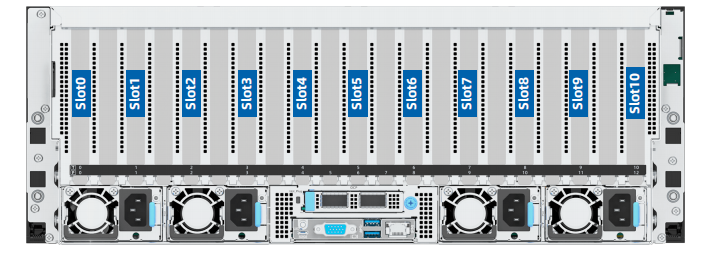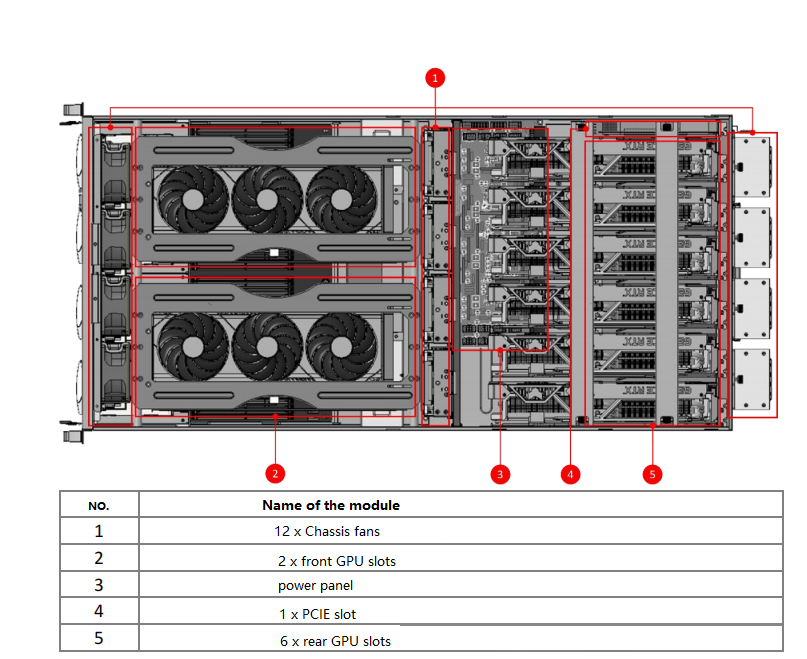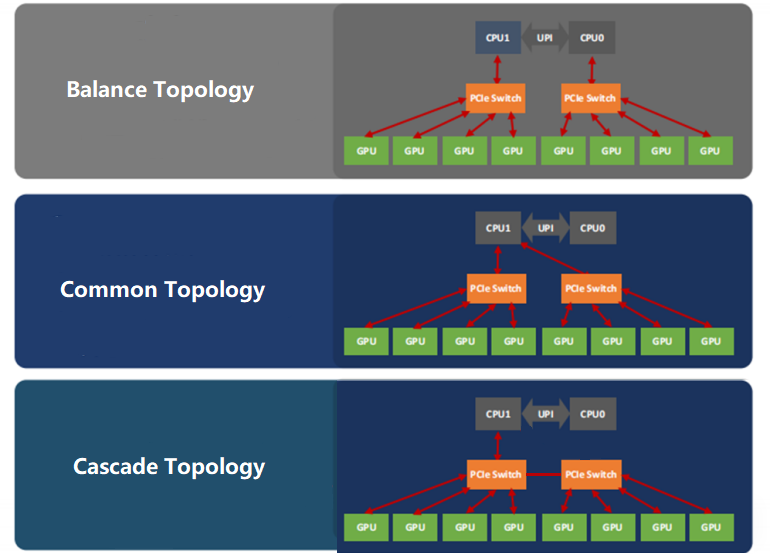The GPU server market has been hot recently, and some customers are wondering whether universal servers can be equipped with GPU cards. Or if a machine only needs 1-2 cards, does it work to adopt a universal server + GPU card? GPU servers and universal servers are the current classification of the server market based on business scenarios. There is no strict distinctions between the two. It can be understood that GPU servers are universal servers optimized to better support GPUs. If we must make a simple comparison between the two, we can discuss it from the following ten aspects.
1. They support different numbers of GPU cards
GPU servers usually support at least 4 GPU cards. The mainstream cards in the market include 4 cards, 8 cards, 10 cards, 20 cards, etc. The cards here refer to standard double-width cards. The following is the rear view of a GPU server for reference. The 8-card GPU slots are slot1-slot8, and the 10-card GPU slots are slot0-slot9.

Rear view of the GPU server
Universal servers: Generally, 2U servers have no more than 4 cards, and 4U servers have no more than 6 cards, which also refers to standard double-width cards.
2. They support different types of GPU card
GPU server: It has good card compatibility. In addition to single-width and double-width, some manufacturers’ models can also support consumer 2.5 or 3-width game cards. For example, the G5208 launched by the Stone Group supports the 8-card fan version 4090, which is a innovative machine. Its GPU support parameters and structure diagram are as follows.

G5208 structure diagram
Universal servers: Mainly single-width and double-width, and cannot support triple-width consumer cards, mainly due to its size and heat dissipation.
3. They have different machine forms:
GPU servers: usually single-node servers, with 4U being the most common in the market, and tower-tower servers, as well as high-end NVlink servers in 5U, 6U, or 8U configurations.
Universal servers: usually in 2U form, but also in 1U height, high-density 2U2, 2U4, 4U8, blade or whole cabinet form, with more diverse product forms.
4. They have different GPU and CPU topology
GPU server: In addition to PCIE direct pass-through, it can also be expanded through PCIE sw. There are various topology types, including balance, common and cascade. It can select more flexibly for different customer business scenarios (training, reasoning, video rendering, etc.), as shown in the following figure.

Comparison of three types of topology
Universal servers: usually PCIE passthrough (rarely through PCIe sw), and the number of supported GPUs is limited.
5. Different brands of servers
GPU server: Except for the leading manufacturers who develop their own platforms (LC, H3C, CJB, LX, etc.), most others use AMD platforms (of course, other ODM manufacturers are not excluded, such as HQ, HS, etc.).
Universal servers: There are dozens of them. Except for the top few companies are highly involved in self-development, most of other companies use assembled servers, with the main focus of cost-effectiveness.
6. Their power consumption of the whole server varies greatly
GPU server: The power consumption is relatively high. Taking the 4090 eight-card server as an example, a server needs more than 4KW. For example, the mainstream Supermicro 8-card platform in the market usually uses a 2+2 2KW power supply (of course, it can also be set to a 3+1 working mode);
Universal servers: Low-end servers are generally 500-550W, and there are also 800W, 100W, 1200W and 1600W servers. Usually, not many servers exceed 2KW.
7. Their prices of a single server are different
GPU server: The platform is 2-3 times that of a universal server. The actual shipment price of one unit can range from 100,000 RMB to millions. This mainly depends on the price of the GPU card. For example, for 8 A100 cards, the cost of the platform accounts for a very small proportion.
Universal servers: It has a large price range from 10,000 RMB to 20,000 RMB to hundreds of thousands RMB, but most of the selling prices are below 100,000 RMB, and the average price is about 30,000 to 50,000 RMB per unit. This is why everyone likes to sell GPU servers now. One GPU server costs ten times as much as others, and if dozens of 4090 eight-card machines are sold, the sales performance task is basically achieved.
8. They have different overall market shares
Going back two years, GPU servers accounted for about 20-25% of the entire server market, while standard servers accounted for more than 70%. Now the GPU market is booming, especially with the construction of AIDC. It is roughly estimated that the shipments of GPU models have exceeded 30% or 40%. According to IDC statistics, the domestic acceleration server market share exceeded 30% in 2024.
9. They have different business scenarios of servers
GPU servers are generally used for video rendering and graphics processing, AI training, AI reasoning, or HPC computing, while standard servers can be used anywhere, such as private clouds, distributed storage, management nodes, and HPC general computing nodes, etc.
10. They are of different urgency of liquid cooling technology requirements
GPU servers are “power hogs” and are the key to reducing the PUE index in intelligent computing centers. Therefore, many intelligent computing centers that are currently under construction or are preparing to be built have planned liquid cooling for GPU servers (both cold plate and immersion). However, the risk lies in the warranty of the GPU card. Once the GPU card is converted to liquid cooling, it might affect the original manufacturer’s warranty (of course, this problem is temporary, and it is not ruled out that GPU manufacturers will launch special liquid cooling models in the future. In fact, NVIDIA launched an A100 single-width liquid-cooled GPU two years ago). Universal servers are not as urgent as GPU servers in terms of liquid cooling and they have a relatively simple structure and are more mature than GPU servers in terms of liquid cooling cold plate conversion or immersion adaptation.
